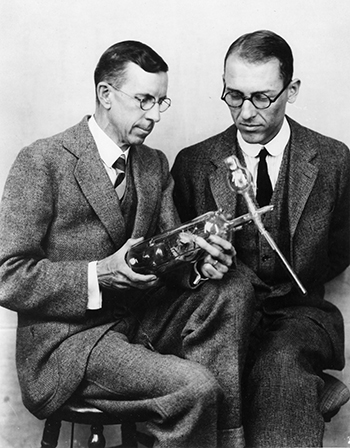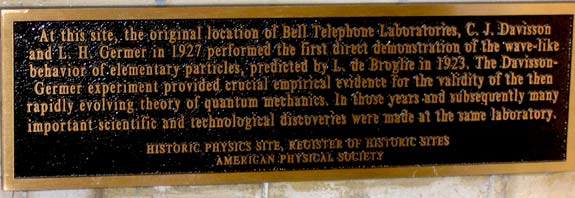Bell Laboratories Building, New York
New York, New York
Confirming Quantum Mechanics

Clinton Davisson (left) and Lester Germer (right) with tube used in electron diffraction work, taken at West Street, New York City, New York.

Plaque Inscription:
"At this site, the original location of Bell Telephone Laboratories, D. J. Davisson and L. H. Germer in 1927 performed the first direct demonstration of the wave-like behavior of elementary particles, predicted by L. de Broglie in 1923. The Davisson- Germer experiment provided crucial empirical evidence for the validity of the then rapidly evolving theory of quantum mechanics. In those years and subsequently many important scientific and technological discoveries were made at the same laboratory."
Bell Labs, the storied research and development engine for the U.S. and beyond, was launched in the 1920s. "It has its roots in the consolidation of several engineering departments within the American Telephone & Telegraph (AT&T) company and the Western Electric company, the manufacturing organization for the Bell System. These departments had been tasked with overcoming the day-to-day engineering challenges of building a national communications network. But as large parts of that network were deployed and the emerging telephone business took hold in the 1920s, attention increasingly turned to exploring fundamental areas of science likely to shape the future of the industry. As a result, about 4,000 of these scientists and engineers were assigned to a newly created Bell Telephone Laboratories, Inc. in 1925, and were to be fully dedicated to such research."1 The Labs were originally located in the West Village of Manhattan, in New York City.
Clinton Davisson, whose Ph.D. was from Princeton University, was one of Bell Labs' early employees. Fascinated by the developments of quantum mechanics, he had been following discoveries made in this field very closely. In particular, Davisson was inspired by the work of Louis de Broglie, a French physicist, who in 1923, had upon observing that light has some of the properties of ordinary particles, simply proposed: If light can be a particle, why can't a particle be a wave? de Broglie constructed a theory extending the results to all particles. The de Broglie hypothesis implied that wave behavior was a universal property of matter.
In 1925, Davisson and his Bell Labs partner Lester Germer began a series of experiments that would, within two years, confirm de Broglie's hypothesis of the wave nature of matter. In recognition of this important discovery, APS honored the location of the experiment as part of its Historic Sites Initiative. In May 2011, Curt Callan, President of APS, presented a plaque to Jeong Kim, President of Alcatel-Lucent Bell Labs, which reads: "At this site, the original location of Bell Telephone Laboratories, C. J. Davisson and L. H. Germer in 1927 performed the first direct demonstration of the wave-like behavior of elementary particles, predicted by L. de Broglie in 1923. The Davisson-Germer experiment provided crucial empirical evidence for the validity of the then rapidly evolving theory of quantum mechanics. In those years and subsequently many important scientific and technological discoveries were made at the same laboratory."
de Broglie's hypothesis was that a simple relationship existed between the velocity of a particle and the wavelength associated with that particle: The greater the particle's velocity, the shorter the wavelength. Thus, if the velocity of the particle is known, it is possible to calculate, by means of de Broglie's formula, the wavelength, and if the wavelength is known, it is possible to calculate the velocity of the particle.
Spurred by this work, "Davisson and Germer designed and built a vacuum apparatus for the purpose of measuring the energies of electrons scattered from a metal surface. Electrons from a heated filament were accelerated by a voltage and allowed to strike the surface of nickel metal."2
"The electron beam was directed at the nickel target, which could be rotated to observe angular dependence of the scattered electrons. Their electron detector (called a Faraday box) was mounted on an arc so that it could be rotated to observe electrons at different angles. It was a great surprise to them to find that at certain angles there was a peak in intensity of the scattered electron beam. This peak indicated wave behavior for the electrons, and could be interpreted by the Bragg law to give values for the lattice spacing in the nickel crystal."3 The experiment showed that electrons behaved like waves, in that they exhibited a diffraction pattern when they scattered off the crystalline structure of the nickel target. It was 1927, in room 7B of Bell Labs, and Davisson and Germer had just proven one of the underlying principles of quantum mechanics.
For his part on the discovery, Davisson received the Nobel Prize for Physics in 1937, for "experimental discovery of the diffraction of electrons by crystals." He shared it with British physicist George Paget Thomson, who had discovered the same phenomenon with a different experimental arrangement. Davisson continued his investigations, in which, among other achievements, he contributed directly to the development of the electron microscope.
Today, the legacy of the dynamic duo of Davisson and Germer lives on. The APS Davisson-Germer Prize in Atomic or Surface Physics is awarded in alternate years in the areas of condensed matter physics, and atomic, molecular, and optical physics. It was established in 1965 by AT&T Bell Laboratories with additional support from the Chope Family Trust.
Of course the innovations that emanated from Bell Labs continued and blossomed, including others that have been recognized with APS historic site plaques. In 1970, Bell Labs moved to its larger, current location in New Jersey, and the West Village site of Bell Labs was converted to the Westbeth Artists Residence. No one is exactly sure where in the Residence the old room 7B is, but Callan promised, "When we find out where in Westbeth that was, we'll put a plaque there, too."
Works Cited
1History of Bell Labs, https://www.bell-labs.com/about/history-bell-labs/2Nave, R., Davisson-Germer Experiment, HyperPhysics, http://hyperphysics.phy-astr.gsu.edu/hbase/quantum/davger2.html
3IBID
